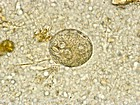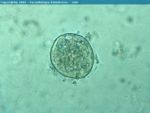Difference between revisions of "Balantidium"
Jump to navigation
Jump to search
| (13 intermediate revisions by 3 users not shown) | |||
| Line 1: | Line 1: | ||
| − | |||
| − | |||
| − | |||
| − | |||
| − | |||
| − | |||
| − | |||
| − | |||
| − | |||
| − | |||
| − | |||
[[Image:Balantidium pig.jpg|thumb|right|150px|''Balantidium'' from a pig - Joaquim Castellà Veterinary Parasitology Universitat Autònoma de Barcelona]] | [[Image:Balantidium pig.jpg|thumb|right|150px|''Balantidium'' from a pig - Joaquim Castellà Veterinary Parasitology Universitat Autònoma de Barcelona]] | ||
[[Image:Balantidium pig trophozoite.jpg|thumb|right|150px|''Balantidium'' trophozoite from a pig - Joaquim Castellà Veterinary Parasitology Universitat Autònoma de Barcelona]] | [[Image:Balantidium pig trophozoite.jpg|thumb|right|150px|''Balantidium'' trophozoite from a pig - Joaquim Castellà Veterinary Parasitology Universitat Autònoma de Barcelona]] | ||
| + | [[Image:Balanditium.jpg|thumb|right|150px|Balantidium coli - trofozoite and cyst - Wikimedia Commons]] | ||
| + | *Ciliate protozoan found as a commensal in the lumen of the [[Large Intestine - Anatomy & Physiology|large intestine]] | ||
| + | *Infects pigs and other animals | ||
| + | **Including humans | ||
| − | '' | + | '''Recognition''' |
| − | + | *Ciliate | |
| − | |||
| − | |||
| − | |||
| − | |||
| − | |||
| − | |||
| − | |||
| − | + | *80μm long | |
| − | |||
| − | |||
| + | *Funnel-shaped depressions leading to the cytostome (mouth) | ||
| − | + | *Kidney shaped macronucleus | |
| − | * | ||
| − | |||
| + | *Small micronucleus | ||
| − | + | *Contractile and food vacuoles | |
| − | |||
| − | |||
| − | |||
| − | + | '''Life Cycle''' | |
| − | + | *Reproduce by binary fission | |
| + | *Thick-walled cysts pass out with faeces | ||
| + | **Ensure infection of a new host | ||
| − | + | '''Pathogenesis''' | |
| + | *Pigs | ||
| + | **Usually commensal | ||
| + | **May cause ulceration and dysentery if the intestinal mucosa is damaged already as parasite will become invasive | ||
| − | + | *Man | |
| + | **Causes ulceration and dysentery | ||
| + | **Infection via consuming contaminated foodstuffs and contact with infected pig faeces | ||
[[Category:Miscellaneous Protozoa]] | [[Category:Miscellaneous Protozoa]] | ||
| − | + | [[Category:To_Do_-_Parasites]] | |
| − | |||
| − | [[Category: | ||
Revision as of 22:15, 26 June 2010
File:Balanditium.jpg
Balantidium coli - trofozoite and cyst - Wikimedia Commons
- Ciliate protozoan found as a commensal in the lumen of the large intestine
- Infects pigs and other animals
- Including humans
Recognition
- Ciliate
- 80μm long
- Funnel-shaped depressions leading to the cytostome (mouth)
- Kidney shaped macronucleus
- Small micronucleus
- Contractile and food vacuoles
Life Cycle
- Reproduce by binary fission
- Thick-walled cysts pass out with faeces
- Ensure infection of a new host
Pathogenesis
- Pigs
- Usually commensal
- May cause ulceration and dysentery if the intestinal mucosa is damaged already as parasite will become invasive
- Man
- Causes ulceration and dysentery
- Infection via consuming contaminated foodstuffs and contact with infected pig faeces

